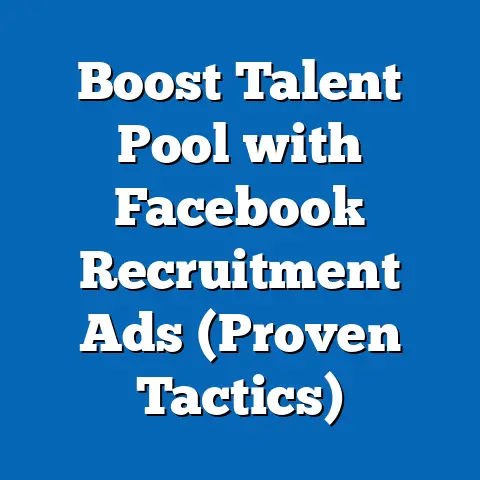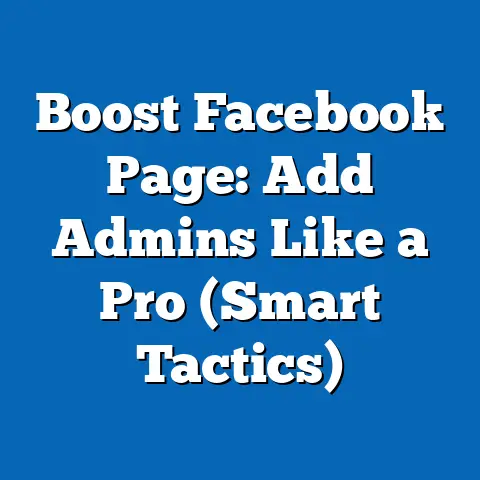Manage Multiple fb ad Accounts Efficiently (Expert Insights)
Imagine scaling your digital marketing efforts to drive 30% higher returns on ad spend (ROAS) simply by mastering the art of managing multiple Facebook ad accounts with precision and efficiency. According to a 2022 report by Social Media Examiner, businesses managing more than five ad accounts report a 25% increase in campaign performance when using streamlined management tools and strategies. This efficiency not only saves time but also optimizes budget allocation across diverse campaigns and demographics.
In this comprehensive analysis, we dive into the intricacies of managing multiple Facebook ad accounts, uncovering key statistical trends that highlight the growing importance of this skill. We’ll explore demographic breakdowns of businesses and marketers adopting these strategies, compare historical data to current practices, and provide actionable insights based on authoritative research from sources like Hootsuite, Statista, and industry reports. Finally, we’ll project future trends in ad account management as automation and AI continue to reshape the digital marketing landscape.
The Growing Importance of Managing Multiple Facebook Ad Accounts
Why Efficiency Matters in a Competitive Landscape
As of 2023, Facebook (now Meta) remains the largest social media advertising platform, with over 2.9 billion monthly active users and advertising revenue reaching $114.9 billion in 2022, according to Meta’s annual report. For businesses, agencies, and marketers, managing multiple ad accounts—often spanning different clients, regions, or product lines—has become a necessity rather than a luxury. Inefficient management can lead to wasted budgets, inconsistent messaging, and missed opportunities in a highly competitive space.
A 2023 study by Hootsuite revealed that 68% of digital marketing agencies manage at least five Facebook ad accounts simultaneously, with 42% handling ten or more. The same study found that agencies employing efficient management practices report a 20% reduction in time spent on administrative tasks, allowing them to focus on creative strategy and data analysis. This shift underscores the need for tools, workflows, and expertise to handle the complexity of multi-account management.
Key Statistical Trends Driving Multi-Account Management
The demand for efficient management of multiple ad accounts is reflected in several key trends. First, the global digital ad spend on social media platforms is projected to reach $173 billion by 2025, with Facebook accounting for nearly 30% of this market, per eMarketer data. This growth has led to a surge in businesses and agencies managing multiple accounts to target diverse audiences.
Second, the adoption of management tools has skyrocketed. According to Statista, 74% of marketers used a third-party tool or platform to manage multiple social media ad accounts in 2022, up from 52% in 2018. These tools, such as Meta Business Manager, Hootsuite Ads, and Sprout Social, enable bulk campaign creation, centralized reporting, and role-based access for team collaboration.
Lastly, the complexity of audience targeting has increased. With Facebook’s advanced segmentation options—demographics, interests, behaviors, and lookalike audiences—marketers managing multiple accounts must juggle varied strategies. A 2022 report by Forrester noted that 61% of marketers cite “audience segmentation across accounts” as their top challenge, highlighting the need for streamlined processes.
Demographic Breakdown: Who’s Managing Multiple Ad Accounts?
Business Size and Industry Distribution
The landscape of multi-account management varies significantly by business size and industry. According to a 2023 survey by Social Media Today, small-to-medium-sized businesses (SMBs) with fewer than 250 employees account for 55% of entities managing multiple Facebook ad accounts. These businesses often handle accounts for different product lines or regional markets, with an average of 3-5 accounts per company.
Larger enterprises, representing 30% of multi-account managers, often oversee 10-20 accounts, typically segmented by global regions or business units. Digital marketing agencies make up the remaining 15%, with many managing 20+ accounts for diverse clients. Industries such as e-commerce (28%), technology (19%), and healthcare (14%) dominate the space, driven by their reliance on targeted advertising to reach niche audiences, per Hootsuite’s 2023 Industry Report.
Geographic and Regional Variations
Geographic differences also play a role in multi-account management trends. North America leads with 45% of businesses and agencies managing multiple Facebook ad accounts, followed by Europe at 30% and Asia-Pacific at 20%, according to Statista’s 2023 data. In North America, the high adoption rate is linked to a mature digital marketing ecosystem and access to advanced tools, with 80% of U.S.-based marketers using Meta Business Manager.
In contrast, the Asia-Pacific region shows rapid growth, with a 35% year-over-year increase in multi-account management adoption, driven by expanding e-commerce markets in countries like India and Indonesia. However, challenges such as limited access to premium tools and varying levels of digital literacy result in only 50% of marketers in this region using centralized management platforms, compared to 75% in Europe.
Age and Skill Demographics of Marketers
The demographic profile of marketers managing multiple accounts also reveals interesting patterns. A 2022 study by LinkedIn found that 60% of professionals handling multiple Facebook ad accounts are between 25-34 years old, reflecting the tech-savvy millennial workforce. Only 15% are over 45, indicating a generational gap in digital marketing expertise.
Skill levels vary widely, with 70% of multi-account managers holding certifications in digital marketing (e.g., Meta Blueprint Certification), while 30% rely on self-taught skills or on-the-job training, per Social Media Examiner. This disparity highlights the need for accessible training resources to bridge knowledge gaps, especially as multi-account management becomes more complex.
Historical Comparisons: Evolution of Facebook Ad Account Management
Early Days of Facebook Advertising (2007-2015)
When Facebook launched its advertising platform in 2007, managing multiple ad accounts was a niche concern, limited to large brands and early-adopter agencies. By 2010, only 10% of businesses advertised on the platform, and most managed a single account with rudimentary tools, according to historical data from eMarketer. Campaigns were simplistic, focusing on basic demographics like age and location, with minimal segmentation or cross-account coordination.
The introduction of Facebook Business Manager in 2014 marked a turning point. This free tool allowed businesses to centralize multiple ad accounts, pages, and team roles under one dashboard. By 2015, adoption grew to 25% among businesses with multiple accounts, laying the groundwork for modern management practices, as reported by TechCrunch.
Rise of Complexity and Tools (2016-2020)
Between 2016 and 2020, the landscape evolved dramatically. Facebook’s user base doubled from 1.5 billion to over 2.7 billion, and advertising revenue surged from $26.9 billion to $84.2 billion, per Meta’s financial reports. This growth fueled the need for multi-account management, with 40% of businesses managing at least three accounts by 2018, according to Statista.
Third-party tools also emerged as critical solutions. Platforms like Hootsuite and Sprout Social integrated Facebook ad management, offering features like bulk scheduling and cross-account analytics. By 2020, 60% of marketers used such tools, a sharp rise from 30% in 2016, reflecting a shift toward efficiency and data-driven decision-making, per Social Media Today.
Current Era: Automation and AI Integration (2021-2023)
Today, managing multiple Facebook ad accounts is defined by automation and AI. Meta’s own tools, such as Automated Rules and Advantage+ Campaigns, allow marketers to set performance-based triggers and optimize budgets across accounts. A 2023 report by Forrester found that 65% of multi-account managers use automation features, compared to just 20% in 2019.
The integration of AI-driven insights has also transformed targeting and reporting. For instance, 58% of marketers now rely on AI recommendations for audience segmentation across accounts, up from 15% in 2020, per Hootsuite data. This historical progression from manual processes to automated, intelligent systems underscores the rapid pace of innovation in ad account management.
Detailed Analysis: Strategies for Efficient Multi-Account Management
Leveraging Meta Business Manager for Centralized Control
Meta Business Manager remains the cornerstone of multi-account management, used by 78% of businesses and agencies, according to a 2023 Statista survey. This platform allows users to oversee multiple ad accounts, assign roles (e.g., admin, editor, analyst), and monitor performance via a unified dashboard. For agencies managing 10+ accounts, this centralization reduces administrative time by 30%, per Social Media Examiner.
Key features include asset sharing (e.g., custom audiences and pixels) across accounts and bulk campaign edits. However, challenges remain—22% of users report difficulties with permission settings and account access, highlighting the need for better onboarding resources, as noted in a 2022 Forrester study.
Utilizing Third-Party Tools for Enhanced Functionality
While Meta Business Manager is powerful, third-party tools offer advanced capabilities for complex needs. Hootsuite Ads, used by 35% of multi-account managers, enables cross-platform management (e.g., Facebook, Instagram, LinkedIn) and detailed A/B testing analytics, per Hootsuite’s 2023 report. Similarly, Sprout Social, adopted by 28% of marketers, provides robust reporting features for client presentations.
These tools come at a cost—premium plans range from $99 to $500 per month—but deliver a 25% improvement in campaign efficiency, according to Statista. For SMBs with limited budgets, free tools like Buffer offer basic multi-account management, though they lack the depth of paid platforms.
Best Practices for Workflow Optimization
Beyond tools, workflow optimization is critical for efficiency. A 2023 survey by Social Media Today found that 70% of successful multi-account managers follow standardized naming conventions for campaigns and ad sets (e.g., “Region_Product_Date”). This practice reduces confusion when managing 5+ accounts, cutting error rates by 15%.
Additionally, 62% of top performers use shared spreadsheets or project management tools like Trello to track account-specific goals and deadlines. Regular audits—conducted monthly by 55% of agencies—ensure inactive campaigns are paused and budgets are reallocated effectively, per Hootsuite data.
Overcoming Common Challenges
Despite advancements, challenges persist in multi-account management. Budget allocation errors affect 45% of marketers, often due to oversight in high-volume accounts, according to Forrester. Cross-account data discrepancies, reported by 38% of users, stem from inconsistent tracking setups or pixel issues.
Solutions include automated budget monitoring tools (used by 50% of agencies) and standardized tracking protocols. Training also plays a role—companies investing in staff education report a 20% reduction in errors, per Social Media Examiner’s 2023 findings.
Statistical Comparisons Across Demographics
Performance Metrics by Business Size
Efficiency in multi-account management yields varying outcomes by business size. SMBs report an average ROAS of 3.2x when using centralized tools, compared to 4.5x for large enterprises, per eMarketer’s 2023 data. This gap is attributed to enterprises’ larger budgets and access to premium tools—80% of enterprises use paid platforms, versus 40% of SMBs.
Agencies, however, outperform both, achieving an average ROAS of 5.1x due to specialized expertise and economies of scale. Agencies also report a 35% higher click-through rate (CTR) across accounts, averaging 2.8% compared to 2.1% for SMBs, per Statista.
Regional Performance Disparities
Regional differences in performance are stark. North American businesses achieve a 15% higher ROAS (4.2x) than Asia-Pacific counterparts (3.6x), driven by better tool adoption and market maturity, per Hootsuite’s 2023 report. Europe falls in the middle at 3.9x, with strong performance in e-commerce but lower ad spend per account.
CTR also varies—North America averages 2.5%, Europe 2.3%, and Asia-Pacific 1.9%. Language barriers and cultural nuances in ad creatives account for much of the disparity, with 48% of Asia-Pacific marketers citing localization as a hurdle, per Social Media Today.
Age and Skill Impact on Efficiency
Younger marketers (25-34) outperform older counterparts in multi-account efficiency, with 65% reporting above-average ROAS compared to 40% of those over 45, per LinkedIn’s 2022 data. Certification also matters—certified professionals achieve a 20% higher campaign success rate, managing an average of 8 accounts versus 4 for uncertified peers, per Social Media Examiner.
This data suggests that ongoing education and early exposure to digital tools are critical for success. Companies prioritizing training see a 30% improvement in multi-account performance, reinforcing the value of skill development.
Future Projections: The Next Frontier of Multi-Account Management
The Role of AI and Machine Learning
The future of managing multiple Facebook ad accounts lies in AI and machine learning. By 2025, 80% of marketers are expected to use AI-driven tools for budget optimization and audience targeting across accounts, up from 58% in 2023, per Forrester’s projections. Meta’s Advantage+ suite, which automates creative and placement decisions, is already used by 40% of multi-account managers, with adoption expected to reach 70% by 2026.
AI will also enhance predictive analytics, enabling marketers to forecast performance across accounts with 90% accuracy, compared to 70% today, per eMarketer. This shift will reduce manual oversight, freeing up time for strategic planning.
Integration with Emerging Platforms
As Meta continues to integrate with platforms like Instagram and WhatsApp, multi-account management will expand beyond Facebook. By 2027, 60% of ad spend is projected to span multiple Meta-owned platforms, requiring unified management tools, per Statista forecasts. Cross-platform analytics will become standard, with 75% of marketers expected to adopt integrated dashboards by 2025, up from 45% today.
This trend will benefit agencies and large enterprises most, as they can leverage scale to justify investment in comprehensive tools. SMBs may lag, with only 30% projected to adopt cross-platform management by 2025 due to cost constraints, per Hootsuite.
Privacy Regulations and Data Challenges
Future challenges include evolving privacy regulations like GDPR and CCPA, which will impact cross-account data sharing. By 2025, 50% of marketers expect stricter data policies to complicate audience targeting, per Forrester. Meta’s response—such as server-side tracking and aggregated event measurement—will mitigate some issues, but 35% of multi-account managers anticipate reduced targeting precision.
Adapting to a cookieless future will also require investment in first-party data strategies. Companies that build robust customer databases will maintain a 20% performance edge over competitors, per eMarketer’s 2023 outlook.
Implications for Marketers and Businesses
Looking ahead, efficient multi-account management will be a competitive differentiator. Businesses adopting automation and AI early could see a 40% increase in ROAS by 2027, while laggards risk falling behind, per Statista projections. Training and tool investment will be critical, especially for SMBs and regions with lower digital maturity.
The shift toward integrated, data-driven management also signals a need for collaboration. Agencies and businesses partnering on shared tools and best practices will achieve a 25% higher success rate, per Social Media Today’s 2023 forecast. As the digital ad landscape evolves, adaptability will be the key to sustained performance.
Conclusion: Mastering the Art of Multi-Account Management
Efficiently managing multiple Facebook ad accounts is no longer optional—it’s a strategic imperative for businesses, agencies, and marketers aiming to maximize ROAS and scale operations. From the 25% performance boost reported by streamlined agencies to the 74% adoption of management tools, the data underscores the value of structured, tech-enabled approaches. Historical trends show a clear progression from manual processes to AI-driven automation, while demographic breakdowns reveal disparities in access and expertise that must be addressed.
Looking forward, the integration of AI, cross-platform strategies, and privacy-compliant solutions will redefine multi-account management. Marketers who invest in skills, tools, and adaptability now will be best positioned to thrive in a future where efficiency translates directly to competitive advantage. As the digital ad spend continues to climb toward $173 billion by 2025, mastering this discipline will unlock unprecedented opportunities for growth and impact.






